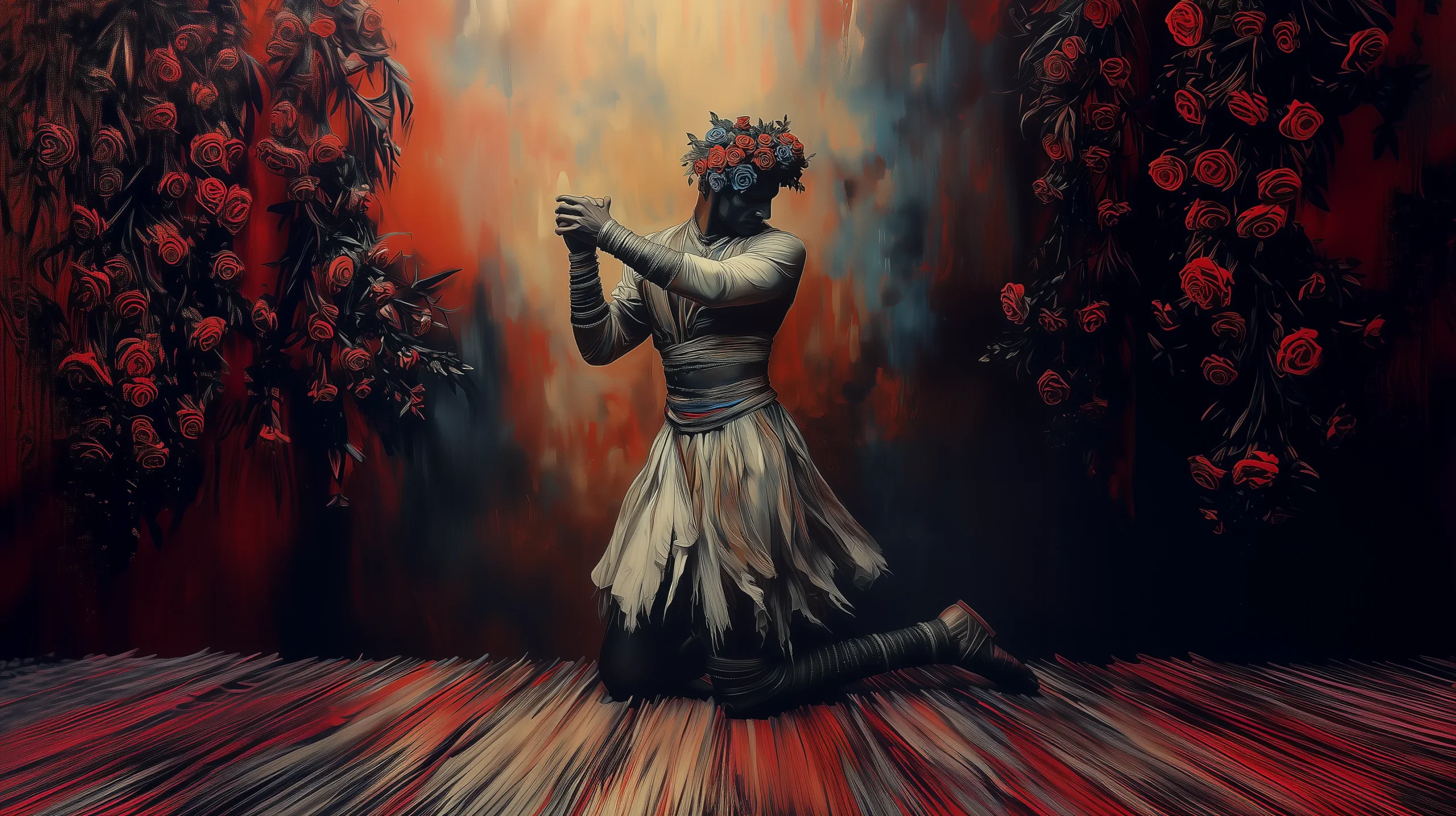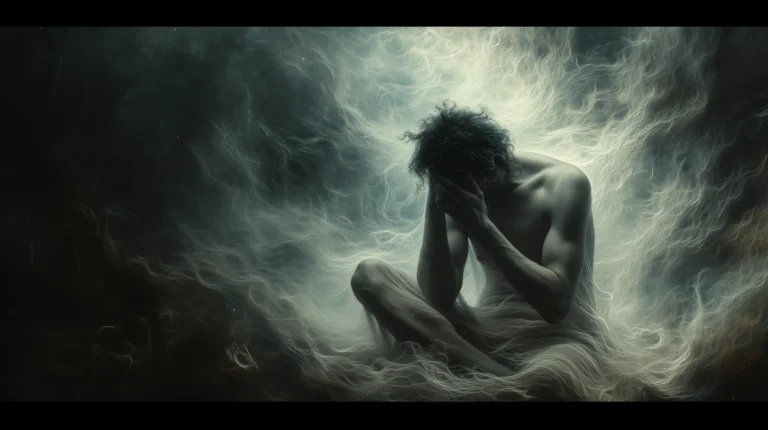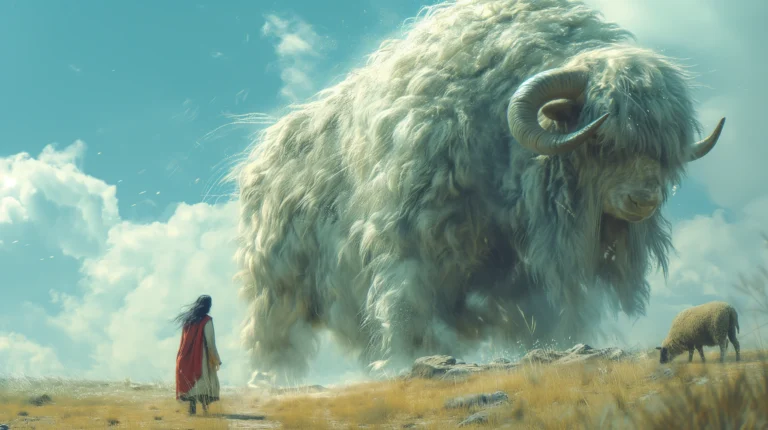The Warrior’s Path: Not Lost, But Found in the Abyss
Not Lost
“Not lost but found in the abyss, I rise—a warrior bound to love, facing the void.”
This guide is an invitation to embark on a journey within, where we confront inner conflicts, embrace the inner judge, and explore the realms of subjective and objective experience.
It’s about discovering order within yourself to navigate the world’s complex layers with clarity.
Through each page, we dive into understanding the warrior spirit—not through force but through love, courage, and a harmonious approach to both inner and outer worlds.
Expect to meet the depths of your own being and the profound wisdom of self-integration as we unravel what it means to walk the path of the true warrior.
The Triad of Transformation
Before exploring the warrior’s path, let’s first look at the journey of self-actualization, realization, and integration—from the Magician’s creative spark to the Sage’s wisdom, and ultimately to the Warrior’s balanced strength.
Magician 1.0: The Self-Actualized
The Magician represents the journey of self-actualization. Here, one explores, discovers, and embraces their unique potential, drawing energy from creativity and the boundless curiosity of youth.
This is the stage of playing with chaos, taking risks, and allowing mistakes to be the stepping stones to personal growth.
Sage 2.0: The Self-Realized
The Sage embodies self-realization, transcending the ego and embracing the wisdom of stillness and surrender.
This is the realm of insight, where the lessons learned by the Magician are distilled into understanding, guiding the Sage to see beyond individual identity and connect with universal truth.
Warrior 3.0: The Self-Integrated
The Warrior embodies self-integration, where enlightenment meets the practical world.
Having united the Magician’s life force (Shakti) with the Sage’s wisdom (Shiva), the Warrior is guided by the heart, allowing love to be the compass of every action.
Grounded yet aware, the Warrior bridges earth and sky, bringing higher consciousness into daily life. Every illusion fades—neti neti—for apart from love, only love endures. Love always wins.
A Path of Inner and Outer Strength
A warrior is often thought of as one engaged in warfare or conflict, yet the true essence of the warrior extends far beyond the battlefield.
A warrior is one who engages in struggle, not only with external foes but with internal forces. A warrior’s journey is one of personal development, evolving to uplift and expand consciousness through trials and self-discovery.
To be a warrior is to walk the path of courage, balance, and mastery of self, transforming one’s deepest fears and conflicts into wisdom and strength.
The Meaning and Origin of the Warrior
The term “warrior” is derived from the Old North French word werreieur, meaning “one who fights.” This archetype has appeared in cultures across history, often representing a figure who embodies strength, resilience, and purpose.
In Native American traditions, the warrior held a sacred role, charged with defending not just the tribe but also its values, spirit, and harmony.
Native American wisdom teaches that to be a warrior is not simply to fight but to protect, to serve, and to uphold a connection with the natural world.
Warriors were often symbolized by the eagle—a creature that flies higher than any other, symbolizing vision, spirit, and freedom.
The eagle represents a warrior’s ability to soar above challenges and to see life from a higher perspective, embodying both the fierce and the spiritual aspects of the warrior path.
The Warrior Archetype and Inner Conflict
As a psychological and mystical archetype, the warrior represents an aspect of ourselves that confronts challenges and pursues growth. Warriors face inner conflicts that arise from fear, doubt, and the shadow aspects of the psyche.
Inner conflict is a struggle between opposing desires, beliefs, or emotions that reside within. This duality is a natural part of the human experience, yet it can lead to suffering if it remains unaddressed.
“Knowing your own darkness is the best method for dealing with the darknesses of other people.”
-Carl Jung
To become a true warrior is to face and integrate this inner darkness, not through force but through understanding.
In the mystical view, the warrior must learn to observe and honor all aspects of themselves, dissolving inner conflict with compassion and self-awareness.
Through love, a warrior acknowledges each part of the self rather than waging war against it, allowing conflicts to dissolve as understanding deepens.
Subjective and Objective Experience
In psychological terms, subjective experience is personal and unique to each individual; it encompasses thoughts, emotions, and perceptions shaped by personal beliefs and past experiences.
The objective experience, on the other hand, is the shared reality we observe with others, the external world in which events and actions unfold.
A warrior engages with both realms: they transform through subjective experiences, such as inner conflict or emotional struggle, while grounding their actions in the objective world.
To illustrate, consider a diamond. In its essence, the diamond is clear, and light passing through it appears white. However, as the light refracts, it reveals a spectrum of colors.
Similarly, the warrior’s consciousness is pure and whole, yet it reflects many facets through subjective experience.
By exploring these aspects, a warrior learns to see both the colors and the light, integrating subjective insights into the objective reality of daily life.
To clarify subjective and objective experience, consider a person climbing a mountain.
The subjective experience is their personal journey—their thoughts, emotions, and physical sensations as they face the climb, the fear, the excitement, or the fatigue.
The objective experience, however, is the mountain itself, the terrain, the weather, and everything shared by all climbers on that path.
Each climber’s subjective experience is unique, but the mountain—the objective reality—remains unchanged in that moment. However, even the objective experience can shift as we discover more about it.
Scientific understanding, for example, continually evolves; we learn new things about mountains, from their geological formation to the ecosystems they support, which were once unknown.
Yet, the ultimate truth is greater than both subjective and objective experiences.
The full reality of the mountain is not just the climb itself or even what we observe from afar; it includes its entire existence—its ancient history, unseen layers, and its interconnection with the earth’s systems.
This truth extends beyond what we can see or study, holding mysteries that transcend both our personal and shared understanding.
In this way, truth is a vast, ever-unfolding reality that encompasses everything we know—and much that we have yet to discover.
Similarly, a warrior recognizes that their subjective and objective experiences are only parts of a much larger reality.
By seeing beyond the limitations of personal views or shared realities, they open themselves to a truth that is vast, interconnected, and beyond individual understanding—a truth that continually guides them toward deeper wisdom.
Power of Gentle Strength
In facing inner conflict, the warrior does not employ brute force. Fighting internal battles with aggression can only lead to fragmentation, bitterness, and suffering. Instead, the warrior cultivates self-compassion, patience, and understanding.
The Buddhist master Thich Nhat Hanh once said,
“To be beautiful means to be yourself. You don’t need to be accepted by others. You need to accept yourself.”
The warrior learns to accept every part of themselves, even the parts that are frightened, angry, or in pain.
Sometimes, the warrior simply observes inner conflict, allowing it to dissolve through awareness alone. In other instances, the warrior gently engages with inner divisions, nurturing them with love and understanding until they transform.
This path requires both strength and tenderness. Through practices like meditation, breath work, exercise, nature walks, cold and hot showers, and mantra, the warrior focuses the mind, calms inner noise, and brings harmony to the inner world.
- Meditation helps the warrior observe without judgment.
- Exercise channels energy in a constructive way.
- Cold and hot showers build resilience and bring clarity.
- Mantras quiet the mind and provide focus.
- Nature walks ground the warrior, connecting them to the natural rhythm and restoring inner balance.
The warrior does not harshly command their inner conflicts to “be quiet.” Instead, they approach these conflicts with patience, listening, and compassion.
A true warrior knows that they cannot silence or reject parts of themselves; instead, they learn to unify them, honoring each part with awareness and understanding.
For example, in a moment of anger, the warrior doesn’t suppress the emotion or allow it to take control. Instead, they take a deep breath, feel the emotion fully, and use its energy with intention.
This might mean responding with assertiveness—communicating firmly and clearly without aggression. Assertiveness, unlike impulsive reaction, is the ability to stand in one’s truth with calm strength, setting boundaries and expressing needs in a balanced way.
At times, the warrior might channel inner tension through exercise, a walk in nature, or physical movement, allowing the energy to flow and release.
Other times, the only option may be to sit with the discomfort, feeling its heat and intensity, and letting the universe transmute it naturally.
In these moments, the warrior practices surrender with patience, embracing the present as it unfolds.
Patience is an act of letting go, a quiet contentment with life’s timing—even when it doesn’t match our expectations.
By trusting that difficult emotions will transform naturally, the warrior finds peace in the rhythm of life as it is.
A warrior’s wisdom lies in knowing when to apply each tool—when breath work or movement is needed, when assertiveness is the answer, and when stillness is the only path forward.
Through experience and inner discernment, a warrior learns to listen deeply, allowing each tool to serve its purpose in the right moment, integrating all energies into a harmonious and balanced self.
A warrior knows that love and understanding are the ultimate conquerors of inner division.
“Only love can truly heal and transform.”
-Ram Dass
In the heart of the warrior lies a love so profound that every illusion, every conflict, can dissolve into it.
In the end, the warrior realizes that love is not just the path but the destination, the unifying force that transforms conflict into peace and duality into wholeness.
A Warrior’s Understanding
Engaging in outer conflict, shouting, and showing anger are often easy responses—they stem from our most primal instincts, our “monkey mind.”
People who rely on loudness and aggression, reacting impulsively instead of responding thoughtfully, may appear strong. But in reality, this behavior reveals a lack of inner depth.
A warrior understands that this need for dominance and aggression often points to inner emptiness, a place where genuine strength and resilience are missing. As Lao Tzu wisely said,
“Mastering others is strength; mastering yourself is true power.”
This understanding allows the warrior to look upon such individuals not with judgment or hate, but with compassion.
The warrior recognizes that each person is on their own journey and that some paths are still far from self-mastery.
Knowing that life is the greatest teacher, the warrior trusts that with time and experience, these individuals may come to learn what cannot be taught through force but only through introspection.
In psychology, dominance is sometimes categorized by archetypes such as the Alpha, Beta, and Omega.
The Alpha tends to be dominant, often leading through control, while the Beta may follow, more passive, finding safety in submission.
The Omega, however, walks a different path, carrying confidence without needing to prove themselves or seek validation from others.
The warrior aligns with the Omega archetype, understanding that true power lies in inner stability, not external displays of control.
A warrior knows that the loudest voices often come from insecurity and that true mastery is quiet, rooted in self-assurance. As Viktor Frankl wisely said,
“Between stimulus and response, there is a space. In that space is our power to choose our response. In our response lies our growth and our freedom.”
The warrior embodies this privilege, recognizing when to engage, how to engage, and when to stand assertively for what is right.
Sometimes it means choosing words over weapons, speaking up firmly yet calmly, or even walking away, knowing that real strength lies not in dominating but in discerning and acting with purpose and integrity.
A warrior is never afraid to take action or to answer with assertiveness, but every response is guided by wisdom, using each tool with precision and understanding.
Through wisdom, the warrior intuitively senses when a situation requires action, compassion, or detachment.
They don’t waste energy on conflicts that do not serve growth but instead channel their efforts toward what aligns with a higher purpose.
In choosing this path, the warrior practices what the Stoics call “apatheia,” a calm resilience in the face of external disturbances, and finds peace in navigating life with deliberate, compassionate strength.
In every encounter, the warrior sees the deeper lessons life offers, learning through every facet of experience. They know that battles are best fought within, transforming impatience into patience, reaction into reflection.
Through wisdom and compassion, the warrior learns to face others—and themselves—with grace, knowing that true victory lies not in conquering others but in mastering the ego and surrendering to their own soul.
The warrior is whole within, complete and satisfied,
Unbound by old patterns, untouched by past graves.
Flowing with life’s endless change, in surrender,
No guilt, no fear, beyond joy and sorrow,
Carried by a peace that rises from merging with existence.
The Soul’s Journey Beyond Illusion
Know this: when the journey begins on the occult path, the magician awakens, and the unseen takes form. Angels and demons come alive, they speak, they reveal themselves.
Yet all this is but the theater of the magician’s imagination, a cosmic play where the mind weaves its illusions.
As the magician matures into the sage, a profound truth emerges. The sage sees through the veil, realizing a reality untouched by thought, beyond the grasp of the human mind.
Here, imagination bows to the eternal, and the sage stands in the clarity of what is real. The Tao that cannot be named whispers silently, for it is neither grasped nor understood, it simply is.
And from this awakening, the warrior is born. The warrior knows that within the psyche lie ancient, primal forces, shadows of the ancestral path that must be walked.
Step by step, the layers are peeled back. Through darkness and shadow, the warrior ventures, unyielding.
What remains before the warrior, when all else has been stripped away, is the Self, the infinite Void, the Nothingness, the Pure Love that is the essence of existence. And in this revelation, the warrior surrenders.
No longer fighting the current of life, the warrior flows with existence itself, becoming one with its rhythm. This is Tantra, the dance of life, where the opposites merge, and the warrior moves as life itself, free, whole, and infinite.
Just like a bird that soars across infinite skies, resting on branches when weary, one must know how to move effortlessly between paths, for as the Upanishad says, forms and rituals are but resting places, the soul’s true journey lies beyond them.
Order Yourself
“The world is a section order; order yourself”
The world is but a sliver of a greater order; align yourself to it. In the vastness of existence, we catch only glimpses of an intricate design—a subtle, rhythmic flow of visible and invisible forces shaping all things.
To order yourself is to bring your inner being into resonance with this cosmic dance, creating harmony within that radiates outward.
To align with the greater order of life is to cultivate an inner balance and quietness of mind, where intuition and intent guide the way.
Intent is the clear purpose we set, a quiet yet powerful focus on what we truly seek.
Intuition is the gentle, often wordless knowing that rises from within, pointing us toward paths we may not yet understand.
In this state of inner harmony, we become attuned to the subtle “crumbs” of intuitive synchronicities—those meaningful coincidences that, when followed, lead us deeper into life’s unfolding dance.
Yet, for these synchronicities to hold true value, one must have a clear intent. A warrior needs this clarity, for intent gives direction to the journey.
For example, if a warrior’s intent is self-mastery, they’ll notice and follow synchronicities that support that goal—perhaps a chance encounter with a mentor, a book recommendation on self-discipline, or even a difficult situation that tests their patience.
Each of these signs becomes a guidepost, pointing them further along the path of self-mastery.
This is the essence of Tantra: moving in harmony with existence, embracing each moment with awareness, openness, and a willingness to let life reveal itself step by step.
Yet, even in Tantra, intent is essential—without it, the path can become chaotic. Clear intent provides direction, guiding the journey, while acceptance allows each experience to unfold naturally.
In the end, the true goal is the expansion of consciousness, as the warrior trusts the path and aligns with the quiet rhythm of the universe.
Listen to your own inclinations,
follow the quiet pull within,
be true to yourself—loose, natural, unmasked.Go slowly; the mind is a delicate realm,
move with the rhythm of your own spirit.Be patient; a warrior honors his pace,
steady and open, with grace in every step.
Now, let’s discuss effective ways to incorporate the principle, ‘The world is a section of order; order yourself,’ more efficiently into our lives.
1. Embrace Your Unique Path
“If a man is not faithful to his own individuality, he cannot be loyal to anything.”
– Claude McKay
You are here with a purpose, a singular expression of life itself. Harmonizing with the world’s order begins with honoring your individuality.
This is not separation; it is the courage to reveal your essence with clarity. Align your actions with your deepest intentions. Each step forward is an act of self-discovery, building the foundation of meaningful alignment.
Insight: True alignment with the world starts with an unwavering embrace of your truest self. Your purpose is the first step toward harmony.
2. Cultivate Harmony in Relationships
“Every one of us is, in the cosmic perspective, precious. If a human disagrees with you, let him live. In a hundred billion galaxies, you will not find another.”
― Carl Sagan, Cosmos
As the world balances many forces, so too must you bring care, empathy, and compassion into your relationships. Harmonizing with the cosmic order involves nurturing connections, both internal and external.
Embrace the dance of cooperation and individuality, where compromise deepens understanding without diminishing who you are. In this, relationships become mirrors, reflecting your own journey back to you.
Insight: Balance your own desires with understanding and openness, knowing relationships are part of the cosmic rhythm, guiding you toward growth.
3. Seek Inner Stillness
“Within you there is a stillness and a sanctuary to which you can retreat at any time and be yourself.”
– Hermann Hesse
In the noise of life, seek the sanctuary of inner stillness. This hidden order, though beyond the visible, is deeply accessible through introspection.
Cultivate moments of quiet, through meditation or simple observation, allowing wisdom to rise from within.
Here, in this inner silence, you glimpse the truths that lie beyond the everyday and connect with the subtleties of existence.
Insight: Through inner calm, you align with life’s subtler energies, seeing beyond surface chaos into the natural order.
4. See Your Inner Reflections
“The outer world is a reflection of the inner world. Change the inner world, and the outer world follows.”
– Eckhart Tolle
The outer world mirrors your inner state. When you perceive disorder or conflict outside, consider any disharmony within.
The universe is steady in its balance; it is our own inner turbulence that distorts it. By attuning your thoughts and actions with inner peace, the world’s order reveals itself as supportive, resonating with your higher purpose.
Insight: Harmonize your inner world, and the outer will appear more ordered and welcoming, aligned with your journey.
5. Honor Your Journey
“Grief can be the garden of compassion. If you keep your heart open through everything, your pain can become your greatest ally in your life’s search for love and wisdom.”
– Rumi
Spiritual growth is not a destination but a deep, flowing journey. The unseen forces of life are always in motion, and in each choice, you are both a part and a guide of this flow.
Walk with humility, curiosity, and a sense of connection to the whole. Attune to the inner voice that whispers of universal truths. Each mindful step brings you closer to the great design, in which your own spiritual journey is woven.
Insight: Life’s order unfolds in layers, and with each deepened awareness, you glimpse a harmony beyond words.
6. Surrender to Existence
“Surrender is the simple but profound wisdom of yielding to rather than opposing the flow of life.”
– Eckhart Tolle
True harmony with existence requires surrender—releasing the ego’s grasp, letting go of resistance, and dissolving the boundaries that separate us from life’s flow.
Ego surrender is not losing yourself but merging with existence in an act of love, embracing the fullness of life as it is. In yielding to life’s wisdom, you discover a profound peace within.
Accepting oneself without judgment opens the door to deeper alignment, where love and fulfillment become your natural state.
Insight: Surrendering the ego is a loving embrace of life, merging you with its vast order and bringing peace in true acceptance.
Reflection
“When you are in alignment with the natural order, everything flows.”
– Lao Tzu
In aligning with the world’s natural order, we begin with the courage to embrace our unique paths. Each step forward, grounded in our true intentions and individuality, creates a foundation for harmony with the universe.
As we cultivate compassionate relationships, seek inner stillness, and recognize that our inner world shapes our outer reality, we unlock new layers of growth and insight.
Honoring our journey means walking humbly, learning from every experience, and allowing life’s rhythm to guide us.
With clear intention and attuned intuition, we move through life in a state of Tantra, harmonizing with existence as it unfolds.
Intention directs our journey, guiding our actions, while intuition reveals the subtle synchronicities along the path.
Ultimately, surrendering to existence opens the door to profound peace, where we dissolve into the greater flow of life, trusting that true alignment is found not through control but through acceptance and love.
Through this inner alignment, the warrior transcends chaos, experiencing reality as a living part of the whole. As the warrior reveals their truest self, life, in turn, reveals its deeper mysteries, reflecting back the harmony within.
The Inner Judge
“Dive within, witness deeply, let the inner judge dissolve.”
The inner judge is a deeply embedded part of our relationship with reality, often appearing in our internal dialogue. This judge is the voice we hear when we critique ourselves, evaluate our worth, or question our actions.
The inner judge can bring up feelings of inadequacy, fear, guilt, or even shame, creating a source of inner suffering and unease.
To develop a non-judgmental self means cultivating a way of seeing yourself—and others—without labels or constant evaluation.
For example, if you make a mistake, rather than falling into self-criticism or inflating yourself with praise when things go well, simply acknowledge the experience. As Rumi said,
“Out beyond ideas of wrongdoing and rightdoing, there is a field. I’ll meet you there.”
This field of non-judgment lets you move beyond the harsh inner judge and step into a mindset of acceptance.
Negative self-judgment may cause tension, agitation, loss of energy, and even anxiety or depression.
These feelings arise because judgment, by its nature, demands constant assessment, leading us away from the present moment and placing us in a cycle of evaluation rather than acceptance.
The inner judge can push us to analyze and dwell on past mistakes or future fears, making it hard to stay centered in the present.
To bring awareness to the inner judge, we need to develop curiosity rather than criticism. When we adopt a curious perspective, we create space for observing our thoughts and feelings without immediately labeling them as “good” or “bad.”
Curiosity allows us to question the voice of judgment and see it as one perspective rather than the ultimate truth.
For example, when feelings of guilt or inadequacy arise, we can pause and ask, “What am I judging myself for, and why?” This simple practice opens a door to self-understanding.
By grounding ourselves in the present, we bring awareness back from the endless cycle of judgment to a place of calm, where we can observe thoughts without reacting to them.
The inner judge gets its energy from pulling us into memories of the past or projections of the future, but in the present moment, it loses its hold.
We learn to let go of judgment and replace it with acceptance, finding compassion for ourselves as we are. When we observe without judgment, we discover that we are whole and worthy just as we are, beyond the standards of the inner judge.
This journey is not about silencing the judge but about understanding its role and creating a healthier, more compassionate dialogue with ourselves.
Through awareness, we can break free from the cycle of judgment and live more fully in each moment, connected to our inherent worth and inner peace.
In psychological, spiritual, and philosophical traditions, self-acceptance, inner peace, and freedom from self-criticism are considered essential steps toward wholeness and well-being.
In non-dualistic philosophy, many traditions encourage us to cultivate the state of being a “witness” to our thoughts and emotions.
This witness space is about observing inner experiences without attachment or judgment, recognizing that we are not the fleeting thoughts and feelings that pass through our mind, but the deeper, unchanging awareness that lies beyond them.
By resting in this witness state, we free ourselves from unnecessary suffering, experiencing a natural peace that comes from simply being present as the silent observer.
The Bhagavad Gita teaches,
“The Self is a friend to the man who masters himself by the Self.”
The mind, when disciplined, becomes a supportive ally, but if left uncontrolled, it can act as an adversary.
This powerful insight from the Bhagavad Gita emphasizes the importance of self-discipline and meditation in transforming the mind into a positive force.
The Bhagavad Gita offers other key insights on the mind:
- The mind is naturally restless and difficult to control, yet it can be guided through consistent practice and detachment.
- The state of the mind shapes one’s overall consciousness, influencing how we experience life.
- Mastery over the mind leads to mastery over the body and speech, aligning one’s actions with inner peace.
- Cultivating the mind’s strength and focus is essential for personal elevation and growth.
These teachings show us that self-mastery through the mind can unlock deeper consciousness, allowing us to live with greater clarity and purpose.
Ancient philosophers like Epictetus taught the importance of separating our sense of self from external events and internal judgments, viewing life’s happenings as neutral.
This practice of observing without attachment helps us cultivate equanimity, reminding us that we are not defined by our thoughts. As Epictetus wisely said,
“Man is not worried by real problems so much as by his imagined anxieties about real problems”
– Epictetus
To engage with this process, sit quietly and observe yourself. Notice the judgments that arise about yourself and others—the inner chatter that critiques, compares, or doubts.
This stream of judgment isn’t your true Self; it’s simply a pattern of thought. As the Gita reminds us, the real Self is the observer, unchanging and pure.
If you notice that the observer within you starts getting entangled with judgments or arguments, gently detach. Imagine yourself rising above the thoughts, becoming non-judgmental, non-critical, and free from shame in this process.
Approach this practice with kindness and curiosity, allowing yourself to observe without force or resistance. Over time, this gentle witnessing brings you closer to the essence of your true Self, experiencing a state of peace and acceptance.
Path to True Freedom
As the warrior transcends the inner judge, they move beyond the sense of personal doership, recognizing that true strength lies in a deeper surrender to life.
“You have the right to work, but for the work’s sake only. You have no right to the fruits of work. Desire for the fruits of work must never be your motive in working. Never give way to laziness, either.
Perform every action with you heart fixed on the Supreme Lord. Renounce attachment to the fruits. Be even-tempered in success and failure: for it is this evenness of temper which is meant by yoga.
Work done with anxiety about results is far inferior to work done without such anxiety, in the calm of self-surrender. Seek refuge in the knowledge of Brahma. They who work selfishly for results are miserable.”
― Bhagavad Gita
This profound truth guides the warrior to see their role in life not as the sole architect of events but as a vessel through which actions flow.
The warrior’s journey is one of realizing that the judgments and doubts that arise within are simply ripples on the surface of consciousness.
As the Gita teaches,
“The wise see that there is action in the midst of inaction, and inaction in the midst of action.”
By remaining grounded as the silent witness, the warrior understands they are not bound by judgments or actions.
They embody an unchanging awareness, observing all things yet untouched by them, and this wisdom guides the warrior to act without attachment, knowing their essence lies beyond the act itself.
In this state, the warrior cultivates an unshakable peace, untouched by praise or blame, by success or failure.
They move through life’s challenges with a quiet courage, aware that true freedom lies in aligning with this deeper Self, transcending the inner judge and its need to label, critique, or control.
Actions flow through the warrior, yet the warrior remains unattached, rooted in the realization that they are not the doer but the presence in which all actions unfold.
This is the path of the true warrior—not one of conquest over others but mastery over the judgmental self, where life’s challenges become opportunities to rise above the judge and embody a strength that flows from inner harmony.
In Tantra, transformation is the ultimate goal. It teaches that before you serve others, you must first be dedicated to your own inner growth. How can you uplift others if you haven’t yet found your own center?
Be fully committed to your inner journey, nurturing your inner light, for only then can you offer true guidance and support to others.
When you begin to love and accept yourself, sitting fully with who you are, real love is born—a love that rises from within.
“I am already given to the power that rules my fate. And I cling to nothing, so I will have nothing to defend. I have no thoughts, so I will see. I fear nothing, so I will remember myself. Detached and at ease, I will dart past the Eagle to be free.”
– Carlos Castaneda
In the warrior’s journey, there is strength in surrender, in letting go of control and trusting that what we need will find its way to us.
When we release the need to control outcomes, we clear the path, allowing life to flow naturally.
True freedom comes when we move forward with an open heart, unburdened and fearless, trusting in the timing of the universe.
This is the warrior’s path: not lost but found in the abyss, rising with purpose, facing the unknown with love, and embracing the journey with courage and ease.
Written in the Stars
Right now things are tough,
How dark the night, rough—
Yet morning comes, far,
It’s written in the stars.
I rise through the haze,
A magician in phase,
Casting light from within,
A sage’s path, my kin.
Who am I? You’ll see,
Your tomorrow, that’s me.
In the shadows I’ve trod,
To find light in the dark.
What I lack is your own,
From your strength, I have grown.
We’re one in the fight,
Blazing bright through the night.
This is the story told,
Of a warrior bold—
Who seeks life’s reason,
In each turning season.
When survival’s not enough,
And the going’s too tough,
I stand with my scars,
It’s written in the stars.
So see you at dawn,
When the night has withdrawn.
Goodbye to the fears,
Hello to new years.
Farewell, sweet sorrow,
See you tomorrow.
Take care in the fray,
Thank you, today.
Good morning, rise true,
Through dark skies, blue—
The warrior’s begun,
Goodbye night; hello sun.
Awaken, rise steady,
Through shadows turned light,
The warrior walks forward,
Leaving behind the night.
Farewell to the dark; the morning’s begun—
Hello, bright day; greet the sun.
I know because it’s written in the stars.
Jolly Warrior
(Verse 1)
I am a jolly warrior, I am a jolly warrior,
What kind of warrior, you ask me now?
A compassionate one, a loving one,
A tiny bit strict, but I get things done!
(Chorus)
I am a jolly warrior, strong and free,
No fear, no guilt, just let me be!
No lack, no loss, I laugh and play,
Marching on along the way.
(Verse 2)
I wear no armor, no heavy shield,
Just a smile I proudly wield.
I’m here, I’m there, with light and cheer,
A loving warrior, far and near.
(Chorus)
I am a jolly warrior, strong and free,
No fear, no guilt, just let me be!
No lack, no loss, I laugh and play,
Marching on along the way.
(Bridge)
With a wink and grin, I make my way,
Bringing courage, come what may.
Life’s a dance, a fearless tune,
I stride beneath the sun and moon.
(Outro)
I am a jolly warrior, bold and true,
Living light and feeling new.
A heart of strength, a soul that’s free,
The jolly warrior—that’s me!







